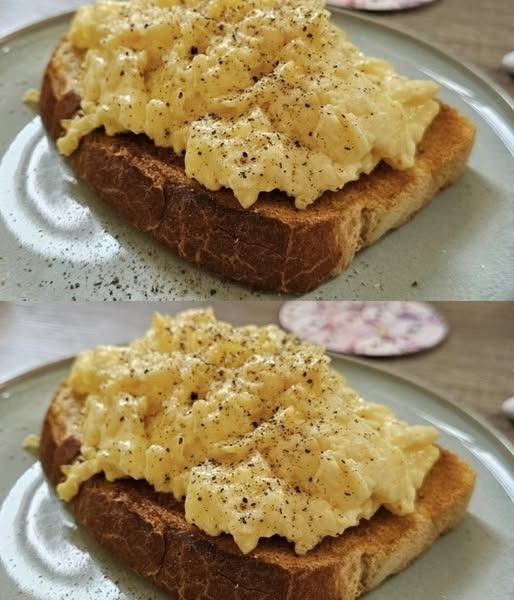
Big Creamy Scrambled Eggs on Toast Recipe (Serves 6–8)
Ingredients:
For the Scrambled Eggs:
- 18 large eggs
- 1¼ cups (300 ml) heavy cream (or whole milk for lighter option)
- 6 tbsp unsalted butter
- 1½ tsp salt (adjust to taste)
- 1 tsp black pepper (plus more for garnish)
- Optional: 1 cup shredded cheese (cheddar, gruyère, or parmesan)
For the Toast:
- 8 thick slices of rustic bread (brioche, sourdough, or white loaf)
- 4 tbsp butter (for spreading/toasting)
Instructions:
- Prep the Eggs:
- In a large mixing bowl, whisk together the eggs, cream, salt, and pepper until fully blended and slightly frothy.
- Cook the Eggs:
- Heat a large nonstick skillet over low heat. Add the butter and let it melt gently.
- Pour in the egg mixture. Stir slowly and continuously with a silicone spatula or wooden spoon.
- As the eggs begin to set, keep stirring to break the curds gently, forming creamy folds.
- Cook until just set but still soft and glossy. Remove from heat immediately — they’ll continue cooking slightly from residual heat.
- Toast the Bread:
- While the eggs are cooking, toast the bread slices until golden brown. Spread with butter if desired.
- Assemble:
- Spoon generous portions of scrambled eggs over each toast slice.
- Sprinkle with a bit more black pepper and grated cheese if you like.
Tips:
- For extra richness, fold in a spoonful of cream cheese or crème fraîche at the end.
- Want variety? Add herbs (chives, parsley), sautéed mushrooms, or crispy bacon bits.
- Serve with a side of fresh fruit or a light salad for a balanced meal.
History of Scrambled Eggs on Toast
Scrambled eggs on toast may seem like a humble dish, but it carries a rich and widespread history that crosses cultures and centuries. Here’s a breakdown of how this simple comfort food became a breakfast staple around the world:
Ancient Beginnings
- Eggs have been a part of the human diet since prehistoric times, and cooked egg dishes date back thousands of years.
- The earliest known references to scrambled-style eggs can be traced back to ancient Rome, where eggs were often cooked with milk, herbs, and sometimes cheese — very similar to modern scrambled egg
Medieval to Renaissance Europe
- In the Middle Ages, eggs were a common ingredient across Europe, especially in monasteries and for peasants. Recipes combining eggs and dairy were common in medieval cookbooks, though the cooking method was more like an omelet or curdled egg dish.
- During the Renaissance, chefs in Italy and France refined egg cookery, including scrambling them gently over low heat — what we now call “French-style scrambled eggs.”
Rise of Toast in Europe
- Toast became more prominent in Europe during the 17th and 18th centuries, as bread became more widely available and toasters or griddles became common in kitchens.
- In Britain, pairing toast with eggs grew in popularity in the Victorian era, especially among the upper and middle class who could afford eggs regularly.
20th Century: The Modern Classic
- By the early 1900s, scrambled eggs on toast had become a standard breakfast in England and the United States, appearing in cookbooks and diners.
- In wartime Britain, eggs (even powdered ones) were often served on toast as a filling and nutritious meal.
- The dish became especially popular in Australia, New Zealand, and the UK, where it remains a breakfast staple.
Global Variations
- Different cultures have added their spin:
- Japan has “tamago toast” (Japanese-style fluffy egg on toast).
- India features “masala scrambled eggs” (Anda Bhurji) served with toast.
- France prefers a creamy, slow-cooked version on crusty bread.
- America often adds cheese, herbs, or bacon on top.
Why It Stuck
- It’s easy, quick, nutritious, and adaptable.
- Eggs provide high-quality protein and fats.
- Toast adds a warm, crunchy base — making the dish both satisfying and comforting.